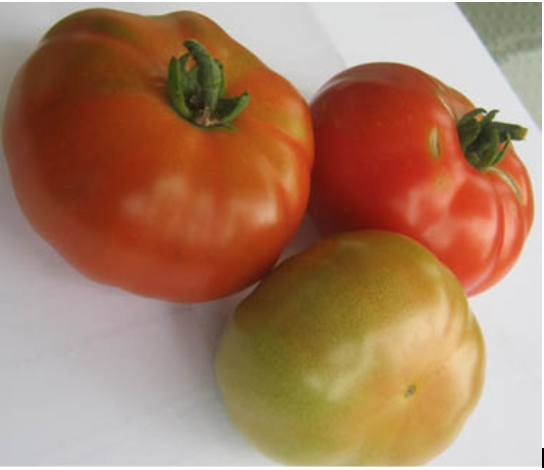Crop: Solanum lycopersicum L. (Tomato)
This landrace has been, at least, cultivated in this area for a century. It is said that its origin is the neighbourhood of Deusto (Bilbao), which was known for its tomatoes, since it is in very favourable conditions for its cultivation due to its south orientation.
The fruit size is medium to small, very juicy, red in colour and crushed. More than half of its fruits are ribbed. They usually have nine or ten cavities or locules. The plant is of indeterminate growth, but the bushes do not usually reach more than two meters and have low leaf density.
It is normally consumed in salad and, when there was a lot of production, it was also used to prepare tomato sauce.
It is a vigorous and very rustic variety, quite productive. It begins to harvest normally at the beginning of August. It continues to produce until the first frosts, which usually occur in November or December. Regarding conservation, they are medium-length tomatoes.
Planting occurs in March for transplant them in May.
The fruits are juicy, with plenty of liquid and a good number of seeds. The taste is pleasant, something sweet and sour.
Cultivation System: ND.
Geographical Information
Country: Spain
It has been cultivated mainly on the right bank of the estuary of Bilbao, extending through the region of Uribe. Currently, it is cultivated mainly in small gardens of the most rural municipalities, especially the towns of Erandio and Sopelana.
Farmer(s) description:
ND.
Propagation system: Seed, self-pollination
Multiplication procedures and consequences on landrace diversity:Some of the best fruits are selected to save the seeds, allowing them to ripen on the plant more than if they were for consumption.
Management plan existence:The landrace management relies completely on farming activities in the area.
Added Values
It is the most widespread and known traditional tomato landrace in these regions. It has traditionally been produced for self-consumption, although it was also sold in local markets, where it was well valued. For decades it was the only variety of tomatoes produced by local gardens. Nowadays, its marketing is rare, always in local markets.
Others (e.g. commercial/geographical brands or special traits):ND.
There are seeds store at the NEIKER-Tecnalia (Research Institute and Agrarian Develop of the Basque Country) under the ID ‘NKT-068’ and, in the seed bank of Euskadi Seed Saver Network (F-138).
Case study provided by Universidad Rey Juan Carlos, Madrid, Spain.
Most of information have been provided by Clara Álvarez Muñiz.
- Cebolla-Cornejo J., Roselló S. & Nuez, F. 2013. Phenotypic and genetic diversity of Spanish tomato landraces. Scientia Horticulturae. 162: 150–16.
- Ibargurengoitia, J. (Seed Savers Network of Euskadi) Contributions to the file of ‘Tomate de Deusto’. In: CONECT-e. ‘Sharing Traditional Ecological Knowledge’, from conecte.es/index.php/es/variedades/475-tomate-de-deusto/descripcion [Accessed in April 2019]. This work is licensed under a creative commons attribution 4.0 international license.
- Tardío, Javier; Pardo de Santayana, Manuel; Morales, Ramón; Molina, María & Aceituno, Laura (editores). 2018. Inventario español de conocimientos tradicionales relativos a la Biodiversidad Agrícola. Vol. 1. Ministerio de Agricultura, Pesca y Alimentación. Madrid. 420 pp.
